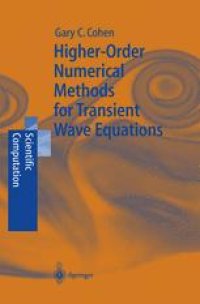
Ebook: Higher-Order Numerical Methods for Transient Wave Equations
Author: Dr. Gary C. Cohen (auth.)
- Tags: Numerical and Computational Physics, Computational Mathematics and Numerical Analysis, Optics and Electrodynamics, Acoustics, Appl.Mathematics/Computational Methods of Engineering
- Series: Scientific Computation
- Year: 2002
- Publisher: Springer-Verlag Berlin Heidelberg
- Edition: 1
- Language: English
- pdf
Solving efficiently the wave equations involved in modeling acoustic, elastic or electromagnetic wave propagation remains a challenge both for research and industry. To attack the problems coming from the propagative character of the solution, the author constructs higher-order numerical methods to reduce the size of the meshes, and consequently the time and space stepping, dramatically improving storage and computing times. This book surveys higher-order finite difference methods and develops various mass-lumped finite (also called spectral) element methods for the transient wave equations, and presents the most efficient methods, respecting both accuracy and stability for each sort of problem. A central role is played by the notion of the dispersion relation for analyzing the methods. The last chapter is devoted to unbounded domains which are modeled using perfectly matched layer (PML) techniques. Numerical examples are given.
Solving efficiently the wave equations involved in modeling acoustic, elastic or electromagnetic wave propagation remains a challenge both for research and industry. To attack the problems coming from the propagative character of the solution, the author constructs higher-order numerical methods to reduce the size of the meshes, and consequently the time and space stepping, dramatically improving storage and computing times. This book surveys higher-order finite difference methods and develops various mass-lumped finite (also called spectral) element methods for the transient wave equations, and presents the most efficient methods, respecting both accuracy and stability for each sort of problem. A central role is played by the notion of the dispersion relation for analyzing the methods. The last chapter is devoted to unbounded domains which are modeled using perfectly matched layer (PML) techniques. Numerical examples are given.
Solving efficiently the wave equations involved in modeling acoustic, elastic or electromagnetic wave propagation remains a challenge both for research and industry. To attack the problems coming from the propagative character of the solution, the author constructs higher-order numerical methods to reduce the size of the meshes, and consequently the time and space stepping, dramatically improving storage and computing times. This book surveys higher-order finite difference methods and develops various mass-lumped finite (also called spectral) element methods for the transient wave equations, and presents the most efficient methods, respecting both accuracy and stability for each sort of problem. A central role is played by the notion of the dispersion relation for analyzing the methods. The last chapter is devoted to unbounded domains which are modeled using perfectly matched layer (PML) techniques. Numerical examples are given.
Content:
Front Matter....Pages I-XVIII
Front Matter....Pages 1-1
The Basic Equations....Pages 3-13
Functional Issues....Pages 15-24
Plane Wave Solutions....Pages 25-30
Front Matter....Pages 31-34
Construction of the Schemes in Homogeneous Media....Pages 35-63
The Dispersion Relation....Pages 65-81
Stability of the Schemes....Pages 83-99
Numerical Dispersion and Anisotropy....Pages 101-121
Construction of the Schemes in Heterogeneous Media....Pages 123-136
Stability by Energy Techniques....Pages 137-144
Reflection-Transmission Analysis....Pages 145-164
Front Matter....Pages 165-168
Mass-Lumping in 1D....Pages 169-210
Spectral Elements....Pages 211-260
Mass-Lumped Mixed Formulations and Edge Elements....Pages 261-305
Modeling Unbounded Domains....Pages 307-330
Back Matter....Pages 331-349
Solving efficiently the wave equations involved in modeling acoustic, elastic or electromagnetic wave propagation remains a challenge both for research and industry. To attack the problems coming from the propagative character of the solution, the author constructs higher-order numerical methods to reduce the size of the meshes, and consequently the time and space stepping, dramatically improving storage and computing times. This book surveys higher-order finite difference methods and develops various mass-lumped finite (also called spectral) element methods for the transient wave equations, and presents the most efficient methods, respecting both accuracy and stability for each sort of problem. A central role is played by the notion of the dispersion relation for analyzing the methods. The last chapter is devoted to unbounded domains which are modeled using perfectly matched layer (PML) techniques. Numerical examples are given.
Content:
Front Matter....Pages I-XVIII
Front Matter....Pages 1-1
The Basic Equations....Pages 3-13
Functional Issues....Pages 15-24
Plane Wave Solutions....Pages 25-30
Front Matter....Pages 31-34
Construction of the Schemes in Homogeneous Media....Pages 35-63
The Dispersion Relation....Pages 65-81
Stability of the Schemes....Pages 83-99
Numerical Dispersion and Anisotropy....Pages 101-121
Construction of the Schemes in Heterogeneous Media....Pages 123-136
Stability by Energy Techniques....Pages 137-144
Reflection-Transmission Analysis....Pages 145-164
Front Matter....Pages 165-168
Mass-Lumping in 1D....Pages 169-210
Spectral Elements....Pages 211-260
Mass-Lumped Mixed Formulations and Edge Elements....Pages 261-305
Modeling Unbounded Domains....Pages 307-330
Back Matter....Pages 331-349
....